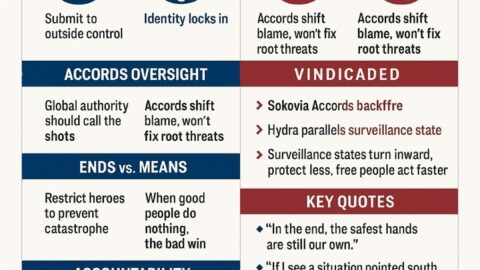Part 1: “Baby It’s Cold Outside” of The Power of Nightmares delves into the origins of two major political ideologies: Islamic fundamentalism and American neo-conservatism. Both movements arose in the mid-20th century and, according to the documentary, share a vision that the modern world is corrupt and in need of drastic change.
Key Details of Part 1:
Sayyid Qutb and Islamic Fundamentalism:
- The first part focuses on Sayyid Qutb, an Egyptian intellectual whose experiences in the United States during the 1940s led him to view Western culture as morally bankrupt. His writings would later inspire the rise of radical Islamist groups, including the Muslim Brotherhood and eventually al-Qaeda.
- Qutb’s ideas, particularly his belief in the need for a violent overthrow of corrupt governments, became foundational to modern jihadist movements.
Leo Strauss and Neo-conservatism:
- Parallel to Qutb’s narrative, the episode introduces Leo Strauss, a German-American political philosopher who believed that liberal democracies were weakening society by promoting individualism and moral relativism.
- Strauss’s ideas influenced a group of American thinkers who later became the neo-conservatives. They believed in using deception and a noble lie to maintain social order and unite the public against a common enemy.
Common Themes:
- Both Qutb and Strauss saw the world in black and white terms: as a struggle between good and evil. They believed the West was in decline and that radical measures were necessary to restore moral clarity and strength.
- The episode emphasizes that while these two ideologies are very different, they share a belief that fear and conflict can be used to galvanize society.
Cold War Parallels:
- The documentary also explores how both ideologies gained influence during the Cold War. The fear of communism in the West and the rise of authoritarian regimes in the Middle East provided fertile ground for these movements.
- The episode suggests that both neo-conservatives and Islamic fundamentalists would later use the fear of terrorism to further their respective agendas.
Shaping the Modern World:
- The episode ends by suggesting that the rise of these two movements set the stage for the post-9/11 world, where the politics of fear would become central to both foreign and domestic policies.
In summary, Part 1 of The Power of Nightmares establishes the intellectual roots of both Islamic fundamentalism and neo-conservatism, showing how each has sought to use fear and conflict to reshape societies.
Part 2: “The Phantom Victory” of The Power of Nightmares examines how both Islamic fundamentalists and American neo-conservatives achieved significant victories in the late 20th century, only to find that their perceived successes were often illusory, and their ambitions led to unintended consequences.
Key Details of Part 2:
Afghanistan and the Soviet Union:
- The episode focuses heavily on the Soviet-Afghan War (1979-1989), where both neo-conservatives and Islamic fundamentalists found a common cause.
- Islamic fundamentalists, including fighters like Osama bin Laden, viewed the war as a holy jihad, believing they could defeat the Soviet superpower through divine will. The U.S., through the CIA, covertly supported the Afghan mujahideen fighters as part of their Cold War strategy to weaken the Soviet Union.
- The neo-conservatives in the Reagan administration, such as Paul Wolfowitz and Richard Perle, saw the war as an opportunity to strike a blow against communism and promote American power. They viewed the Soviet defeat as proof that aggressive intervention and support for anti-Soviet insurgents could bring about victory.
The “Phantom” Victory:
- Both the Islamic fundamentalists and the neo-conservatives believed they had achieved great victories with the Soviet withdrawal from Afghanistan in 1989.
- For the Islamic fundamentalists, this event reinforced their belief that they could take on and defeat a superpower through jihad, leading to a surge in radical Islamist movements.
- For the neo-conservatives, it validated their belief in the aggressive projection of U.S. power abroad and the promotion of democracy through force.
- However, Curtis argues that these victories were illusory—“phantom victories”. The Soviet Union collapsed more due to internal economic and political factors than the efforts of the mujahideen or U.S. intervention.
Unintended Consequences:
- In the wake of the Soviet withdrawal, Afghanistan was left in a state of chaos and civil war, which led to the rise of the Taliban and provided a fertile environment for the growth of terrorist groups like al-Qaeda.
- The neo-conservatives, meanwhile, turned their attention to the Middle East after the Cold War, believing they could reshape the region through American intervention. The 1991 Gulf War was one such attempt, but it failed to remove Saddam Hussein, a key goal of the neo-conservatives.
The Rise of al-Qaeda:
- Curtis explores how Osama bin Laden and other jihadists, emboldened by their perceived victory over the Soviets, began targeting the United States, which they viewed as the next major enemy of Islam.
- The episode shows the transition of Islamic fundamentalism from a regional struggle to a global jihadist movement, with figures like Ayman al-Zawahiri and bin Laden leading the charge against the West.
Disillusionment:
- By the late 1990s, both Islamic fundamentalists and neo-conservatives faced setbacks. The neo-conservatives struggled to maintain influence after the Cold War, while the Islamists found it increasingly difficult to rally popular support for their cause in the Muslim world, particularly after the failed uprisings in countries like Egypt and Algeria.
Building Toward 9/11:
- The episode ends by setting the stage for the events of 9/11, showing how both movements—while facing challenges—would find renewed purpose and opportunity in the new millennium, driven by the politics of fear and the perceived need for a dramatic confrontation between good and evil.
In summary, Part 2 of The Power of Nightmares reveals how both neo-conservatives and Islamic fundamentalists misinterpreted their respective successes in the 1980s, leading them to push for increasingly aggressive and dangerous policies in the 1990s, setting the stage for future conflicts.
Part 3: “The Shadows in the Cave” is the final installment of The Power of Nightmares. It focuses on the aftermath of 9/11 and how the politics of fear has shaped both domestic and foreign policies in the West. The episode critically examines the war on terror, exploring how the threat of terrorism was exaggerated and manipulated by governments to justify actions that would otherwise be politically unacceptable.
Key Details of Part 3:
The Rise of al-Qaeda as a Global Threat:
- The episode begins with the attacks of September 11, 2001, which the U.S. government claimed were orchestrated by al-Qaeda, led by Osama bin Laden. This led to the launch of the “War on Terror” under the Bush administration.
- Adam Curtis argues that al-Qaeda was not the centralized, global network that the U.S. government portrayed. Rather, it was a loose association of various Islamist groups, with bin Laden playing a much smaller role than was claimed. The documentary asserts that the concept of al-Qaeda as a hierarchical, structured organization was largely a myth created by governments to justify military interventions and the curtailing of civil liberties.
Neo-conservatives and the War on Terror:
- Neo-conservatives within the Bush administration, including figures like Dick Cheney and Donald Rumsfeld, used the fear of terrorism to push forward their agenda of reshaping the Middle East and expanding U.S. influence through military intervention.
- The documentary explains how the idea of a global, omnipresent terrorist network was constructed to create a narrative of fear, which enabled the invasion of Afghanistan (2001) and Iraq (2003). Curtis argues that the U.S. government exaggerated the threat posed by these countries, particularly Iraq, which was falsely accused of harboring weapons of mass destruction (WMDs) and having ties to al-Qaeda.
The Myth of the Sleeper Cells:
- The episode also focuses on the fear of terrorist sleeper cells, which were said to be present in Western countries, waiting to strike. This narrative led to widespread panic and the implementation of drastic security measures, including mass surveillance and the erosion of civil liberties in the name of national security.
- Curtis suggests that these sleeper cells were largely fictitious and that the threat was overblown to justify increased government control and the restriction of individual freedoms.
The Role of Fear in Western Politics:
- Curtis argues that after the end of the Cold War, politicians in the West struggled to find a new sense of purpose and direction. In the absence of a clear enemy, they turned to the politics of fear, using the threat of terrorism to unite and control populations.
- This fear was used to legitimize wars abroad, such as the invasions of Afghanistan and Iraq, and to pass legislation at home, like the USA PATRIOT Act in the United States, which greatly expanded government powers of surveillance and detention.
Islamic Fundamentalism’s Decline:
- Curtis also explores the disillusionment of Islamic fundamentalists in the late 1990s and early 2000s. After the failures of Islamist uprisings in countries like Algeria and Egypt, many of the leading figures in the movement, such as Ayman al-Zawahiri, began targeting the West in an attempt to reignite their cause.
- However, Curtis argues that their ability to recruit and inspire global jihad was limited and that the danger posed by these groups was inflated by Western governments.
The Endless War:
- The episode suggests that the war on terror, like the Cold War before it, became a self-perpetuating conflict. With no clear end in sight, it provided a constant justification for military actions, increased security measures, and the politics of fear.
- Curtis contends that both neo-conservatives and Western governments benefitted from maintaining the perception of an ongoing, existential threat, even as the actual threat of terrorism was relatively limited.
In Part 3, Curtis delivers a critique of how governments, particularly in the West, have used fear—of terrorism and an illusory al-Qaeda network—to control populations, justify wars, and expand their powers. The episode concludes that much of the fear of terrorism is based on myths and exaggerations, and that this has led to a perpetual state of war and a loss of civil liberties. It challenges viewers to question the reality of the threats presented by their governments and the impact of living in a world dominated by the politics of fear.







